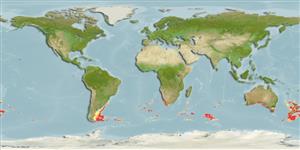>
Aulopiformes (Grinners) >
Notosudidae (Waryfishes)
Etymology: Scopelosaurus: Greek, skopelos = a lantern fish + Greek, sauros = lizard (Ref. 45335).
Eponymy: Harold Hamilton (1885–1937) was a biologist who graduated from Otago University, New Zealand. [...] (Ref. 128868), visit book page.
More on author: Waite.
Environment: milieu / climate zone / depth range / distribution range
Ecología
marino bentopelágico; oceanodromo (Ref. 51243); rango de profundidad ? - 1000 m (Ref. 6602). Temperate; 30°S - 61°S
Atlantic, Indian and Pacific: in sub-Antarctic areas. Not known from the Southeast Pacific.
Tamaño / Peso / Age
Maturity: Lm ? range ? - ? cm
Max length : 50.0 cm TL macho / no sexado; (Ref. 6602)
Short description
Claves de identificación | Morfología | Morfometría
Espinas dorsales (total) : 0; Radios blandos dorsales (total) : 10 - 13; Espinas anales: 0; Radios blandos anales: 18 - 21. Dark brownish to blackish in color; paler below with no silvery scales; when specimen is without scales, an indistinct blackish anal spot of the peritoneum showing through the skin may be observed (Ref. 6602).
Larvae and juveniles pseudoceanic in midwater; adults taken by both bottom and pelagic trawls in about 600-800 m. Sub-adults and adults migrate to the Southern Ocean (to 60°S) to feed; on euphausiids, hyperiids, and other crustaceans as well as on small fishes, like myctophids; juveniles take small zooplankton, especially copepods.
Life cycle and mating behavior
Madurez | Reproducción | Puesta | Huevos | Fecundidad | Larva
Krefft, G., 1990. Notosudidae. p. 136-137. In O. Gon and P.C. Heemstra (eds.) Fishes of the Southern Ocean. J.L.B. Smith Institute of Ichthyology, Grahamstown, South Africa. (Ref. 5175)
IUCN Red List Status (Ref. 130435: Version 2024-2)
Threat to humans
Harmless
Human uses
Pesquerías: sin interés
Herramientas
Special reports
Download XML
Fuentes de Internet
Estimates based on models
Preferred temperature (Ref.
123201): 1.6 - 12.6, mean 7.1 °C (based on 276 cells).
Phylogenetic diversity index (Ref.
82804): PD
50 = 0.5001 [Uniqueness, from 0.5 = low to 2.0 = high].
Bayesian length-weight: a=0.00295 (0.00121 - 0.00721), b=3.18 (2.96 - 3.40), in cm total length, based on LWR estimates for this (Sub)family-body shape (Ref.
93245).
Nivel trófico (Ref.
69278): 3.4 ±0.40 se; based on food items.
Fishing Vulnerability (Ref.
59153): Moderate vulnerability (40 of 100).
